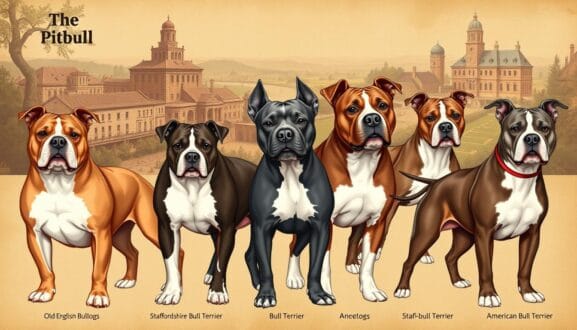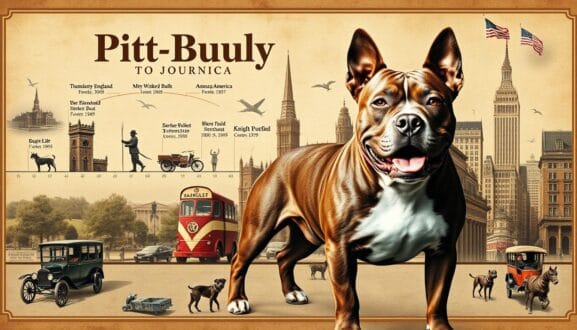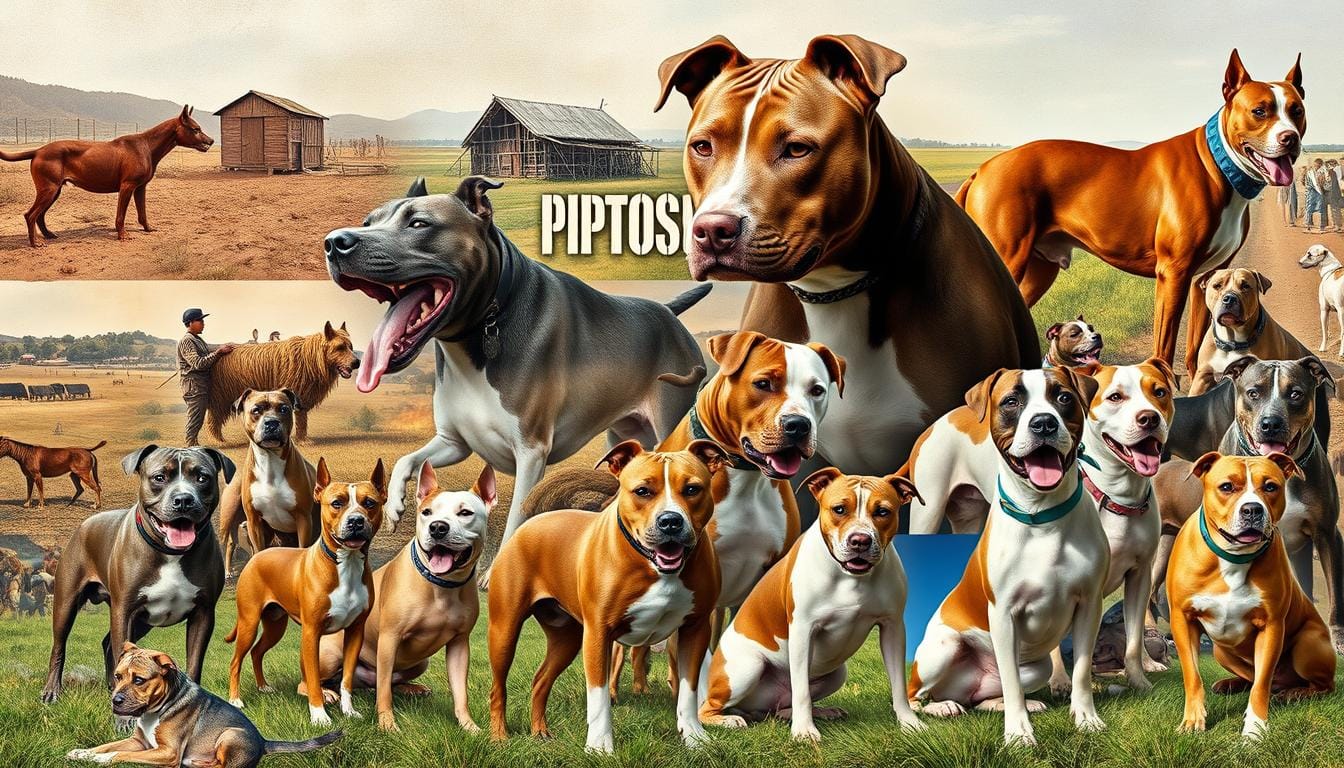Get ready to explore the fascinating story of the pitbull breed. We’ll travel back in time to learn about its origins. From ancient Molossian dogs to the modern American Pit Bull Terrier, this journey shows how dogs adapt and thrive.
Together, we’ll uncover the highs and lows of the pitbull’s history. This will give you a deeper understanding of this remarkable breed.
Learning about the history of pitbull origin, opens a new world. You’ll see how these dogs have touched human lives, both positively and negatively. As we dive into their history, you’ll appreciate the breed’s complexity and evolution.
Get ready to travel through time. We’ll see key moments that shaped the pitbull into the iconic breed it is today.
- Understanding the Ancient Roots of Fighting Dogs
- Pitbull Origin: From British Isles to Modern Day
- The Evolution of Bull-Baiting Sports in England
- Development of the Old English Bulldog Lineage
- The Emergence of Terrier Breeds in Britain
- Immigration to America: A New Chapter Begins
- The Birth of the American Pit Bull Terrier
- Role in American History and Culture
- FAQ:
- Where did pitbulls originate from?
- What two breeds make a pitbull?
- Are pitbulls natural breeds?
- What is Pitbulls country of origin?
- How strong is a Pitbull?
- How did the pitbull breed develop throughout history?
- What is the significance of the Old English Bulldog in the pitbull's lineage?
- How did terrier breeds influence the evolution of the pitbull?
- What has been the role of pitbulls in American history and culture?
Understanding the Ancient Roots of Fighting Dogs
To understand the rich history of pitbulls, we must look back to ancient times. The Molossian dogs of ancient Greece are at the heart of this story. These dogs were known for their strength, courage, and loyalty. These qualities shaped the pitbull lineage for centuries.
Early Molossian Dogs and Their Impact
The Molossian dogs came from Epirus in ancient Greece. They were big, muscular, and fearless. These dogs fought in wars, guarded animals, and even participated in dog fights.
Their influence can be seen in the pitbull roots. Their genetics and physical traits helped create later fighting dog breeds.
The Role of Ancient Rome in Fighting Dog Development
When the Roman Empire grew, they brought Molossian dogs to new lands. The Romans loved blood sports and improved these dogs for gladiatorial battles and public shows. This time saw the start of many fighting dog breeds, each with its own pitbull ancestry and special traits.
“The Molossian dogs were the foundation upon which many of the world’s most powerful and courageous canine breeds were built.”
By exploring the pitbull’s ancient roots, we learn more about its history and unique traits. From the Molossian dogs to the Roman Empire’s innovations, the pitbull ancestry shows the lasting power and resilience of these dogs.
Pitbull Origin: From British Isles to Modern Day
The pitbull’s story is fascinating, tracing back to the British Isles. It has made a lasting impact on both sides of the Atlantic. The breed’s journey shows its resilience and adaptability.
The pitbull’s roots are in the British Isles, linked to the pit bull terrier. It was shaped by blood sports like bull-baiting. Later, it became known for dog fighting, refining its traits.
When the pitbull came to the United States, it found new roles. It became a loyal companion, service animal, and pop culture icon. Despite controversy, the breed’s versatility has made it a key part of American culture.
| Key Milestones in Pitbull Origin | Timeline |
|---|---|
| Ancient Molossian Dogs and Their Impact | Pre-Roman Era |
| Rise of Bull-Baiting Sports in Medieval Britain | Middle Ages |
| Emergence of Terrier Breeds in Britain | 18th-19th Centuries |
| Immigration to America and the Birth of the American Pit Bull Terrier | Late 19th Century |
The pit bull terrier origins weave a story of history, resilience, and cultural importance. As the breed evolves, it reminds us of the complex bond between humans and dogs.
The Evolution of Bull-Baiting Sports in England
The history of the pitbull breed is closely tied to the rise of blood sports in medieval Britain. This includes the brutal bull-baiting practices and the shift to dog fighting. These changes played a key role in shaping the American Pit Bull Terrier heritage.
Rise of Blood Sports in Medieval Britain
In the medieval era, blood sports like bull-baiting became very popular. The British aristocracy and working classes enjoyed these events. Dogs were set on a tied bull, causing it pain for the crowd’s entertainment.
Legislative Changes and Their Effects
As people grew concerned about bull-baiting’s cruelty, the British government tried to stop it. But these efforts only made dog fighting more popular. It became a secret sport that continued to grow.
Transition from Bull-Baiting to Dog Fighting
With bull-baiting’s decline, dog fighting became the new favorite sport. Breeders started to breed dogs for this new sport. This shaped the pitbull history and the American Pit Bull Terrier heritage.
“The transition from bull-baiting to dog fighting was a pivotal moment in the history of the pitbull breed, as it continued to refine the traits that would come to define the American Pit Bull Terrier.”
Development of the Old English Bulldog Lineage
The pitbull genetic background is rich and fascinating. The Old English Bulldog played a key role in this story. This breed’s unique looks and strong spirit helped shape the modern pitbull. Knowing about the Old English Bulldog’s origins and evolution helps us understand the pitbull ancestry.
In Britain, the Old English Bulldog was bred for bull-baiting. These dogs were known for their strong jaws and fearless nature. As bull-baiting became more popular, so did the need for these dogs. This need shaped the breed’s characteristics over time.
- Massive, stocky build with a broad head and short muzzle
- Powerful, low-slung body with a muscular neck and shoulders
- Tenacious and unrelenting in their pursuit of prey
- Loyal and devoted companions, despite their fearsome reputation
The Old English Bulldog was highly valued for its bravery and strength. It was not just for blood sports but also as a working dog and loyal friend. The breed’s genetic makeup was influenced by its role in the arena, setting the stage for the modern pitbull.
| Characteristic | Old English Bulldog | Modern Pitbull |
|---|---|---|
| Body Type | Massive, stocky build | Muscular, athletic build |
| Head Shape | Broad, short muzzle | Broad, slightly tapered muzzle |
| Temperament | Tenacious, fearless | Loyal, confident |
| Purpose | Bull-baiting, working dog | Companionship, some working roles |
The Old English Bulldog’s impact on the pitbull genetic background is clear. By studying this breed, we learn more about the pitbull’s history and evolution. This breed has become a big part of American culture and history.

The Emergence of Terrier Breeds in Britain
The rise of terrier breeds in Britain was key in shaping the pitbull. These dogs were hardworking and tenacious. They had traits that helped form the pitbull we know today.
Working Terrier Characteristics
Terriers were fearless, agile, and adaptable hunters. Their small size let them hunt underground. They were also great at blood sports like rat-baiting.
These traits, along with their strength and agility, caught the eye of breeders. They wanted a more formidable fighting dog.
Crossbreeding Practices and Results
Breeders in Britain started crossbreeding terriers with larger breeds like the Old English Bulldog. This created the bull-and-terrier. It had the terrier’s tenacity and the bulldog’s strength.
These dogs were popular for blood sports. They laid the groundwork for the modern pitbull breed development and pitbull lineage.
The crossbreeding and the bull-and-terrier breeds were a big step in the pitbull’s evolution. They set the stage for the breed’s journey to America and its rise in popular culture.
Immigration to America: A New Chapter Begins
As immigration waves hit the Atlantic, pitbull-type dogs made their way to America. This was a big step in the pitbull history and the start of the American Pit Bull Terrier heritage.
These dogs, brought by their owners, quickly settled into their new home. They became important parts of early American life. They were friends, protectors, and even took part in sports and work.
- Pitbull-type dogs were key to immigrant families, offering safety, friendship, and a link to their past.
- Their strength and agility made them useful for hard tasks, like farm work, hunting, and fighting pests.
- Through tough times, these dogs stood strong with their owners, building a bond that went beyond borders and cultures.
Over time, the American Pit Bull Terrier became its own breed, shaped by America’s challenges and chances. This period set the stage for its lasting impact and complex role in American culture.
“The pitbull-type dogs that arrived with immigrants became the embodiment of the American spirit – resilient, adaptable, and fiercely loyal to their people.”

| Key Characteristics of Pitbull-Type Dogs in Early America | Impact on American Society |
|---|---|
|
|
The Birth of the American Pit Bull Terrier
The American Pit Bull Terrier came to be, with roots in the British Isles. It has a history tied to bull-baiting and dog fighting. As bull-baiting faded in England, fans wanted a new dog for dog fighting.
Early Breed Standards and Recognition
In the late 19th century, American breeders started working on the pit bull terrier. They aimed to create a dog that was strong, quick, and loyal. They wanted a dog that was also loving to people.
Notable Bloodlines and Breeders
Important bloodlines and breeders shaped the pit bull terrier origins and pitbull evolution in the early 20th century. People like “Ragtime” Rader, John P. Colby, and Charles “Sherlock” Hatley were key. They helped make the breed what it is today.
Thanks to these enthusiasts, the American Pit Bull Terrier became well-known and loved. It’s now a favorite pet and working dog in many homes. Its mix of strength, speed, and love has made it a standout in the dog world.
Role in American History and Culture
The American Pit Bull Terrier has a long history in America. They have been hardworking companions, loyal pets, and symbols of strength. From farm dogs to beloved family members, their heritage is deeply American.
In the 20th century, pitbulls became a big part of American culture. They were in movies, TV, and even military ads. Their loyalty and strength made them great family pets. But, they also faced negative stereotypes due to dog fighting.
Despite these challenges, pitbulls are still loved in America. Today, they are therapy dogs, search-and-rescue dogs, and loving family pets. The American Pit Bull Terrier is a key part of our history, showing the resilience and diversity of our nation’s dogs.
FAQ:
Where did pitbulls originate from?
The pitbull breed has a long and complex history. It comes from ancient Molossian dogs of Greece. These dogs were strong and muscular, used in fighting sports.
Over time, these dogs evolved in the British Isles. This led to the modern pitbull breed we know today.
What two breeds make a pitbull?
Pitbulls are a result of crossbreeding two breeds: the Bulldog and the Terrier. The goal was to create a dog with the strength of the Bulldog and the agility of the Terrier. The pitbull origin lies in England, where these traits were selectively combined for tasks like bull-baiting.
Are pitbulls natural breeds?
Pitbulls are not considered a naturally occurring breed but rather a product of selective breeding. The pitbull origin traces back to crossbreeding bulldogs and terriers in England, aimed at creating a strong, agile dog for specific tasks. As a result, the breed developed distinct traits suited to various working roles.
What is Pitbulls country of origin?
Pitbulls originated in England, where they were bred by crossing bulldogs and terriers. The goal was to create a strong, agile dog for bull-baiting and other physically demanding tasks. Today, the pitbull origin continues to influence the breed’s reputation for strength, determination, and loyalty.
How strong is a Pitbull?
Pitbulls are known for their impressive strength, particularly in their muscular build and powerful jaws. Despite their compact size, they possess remarkable stamina and agility. The pitbull origin traces back to working dogs bred for bull-baiting, giving them the strength and determination they are renowned for today.
How did the pitbull breed develop throughout history?
The rise of blood sports like bull-baiting in medieval Britain shaped the pitbull. These sports influenced the breed’s look and behavior.
As blood sports were banned, dog fighting became more popular. This led to further refinement of the pitbull. Immigrants brought the breed to the United States, where it continued to evolve.
What is the significance of the Old English Bulldog in the pitbull’s lineage?
The Old English Bulldog is a key ancestor of the pitbull. Its muscular build and strong jaws were important in the pitbull’s development. The Old English Bulldog’s genes have shaped the pitbull’s look and behavior.
How did terrier breeds influence the evolution of the pitbull?
Terrier breeds in Britain were crucial in the pitbull’s evolution. Terriers were agile, tenacious, and had a strong prey drive. They were crossed with bulldog-type dogs, creating bull-and-terrier breeds.
These breeds were ancestors of the modern pitbull. They added to the pitbull’s versatility and adaptability.
What has been the role of pitbulls in American history and culture?
Pitbulls have played many roles in American history. They were working dogs and beloved family pets. They are part of American culture, but have faced challenges in public perception.
There are ongoing debates about the pitbull’s place in modern American life.
Share your thoughts in the comments below! If you enjoyed this post, consider subscribing to our newsletter for more pet tips, stories and blogs!

